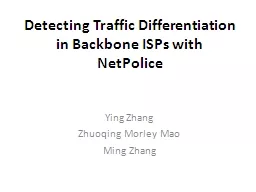

NetPolice Ying Zhang Zhuoqing Morley Mao Ming Zhang CONTENTS INTRODUCTION TRAFFIC DIFFRENTIATION METHODLOGY IMPLEMENTATION REDUCING NOISE EFFECTS EXPERIMENTAL RESULTS SYSTEM EVALUATION ID: 643846
Download Presentation The PPT/PDF document "Detecting Traffic Differentiation in Bac..." is the property of its rightful owner. Permission is granted to download and print the materials on this web site for personal, non-commercial use only, and to display it on your personal computer provided you do not modify the materials and that you retain all copyright notices contained in the materials. By downloading content from our website, you accept the terms of this agreement.
Slide1
Detecting Traffic Differentiation in Backbone ISPs withNetPolice
Ying
Zhang
Zhuoqing
Morley
Mao
Ming ZhangSlide2
CONTENTSINTRODUCTION
TRAFFIC DIFFRENTIATION
METHODLOGY
IMPLEMENTATION
REDUCING NOISE EFFECTS
EXPERIMENTAL RESULTS
SYSTEM EVALUATION
CONCLUSIONSlide3
INTRODUCTIONAIM:
In
this paper, we consider the problem of detecting traffic
differentiation in
backbone ISPs
.
PURPOSE:
The
ability to detect traffic
differentiation enables
customers to develop
appropriate strategies
for
improving their
application performance.Slide4
INTRODUCTION …contd
CHALLENGES:
To build such a system
, we
face two key challenges
:
i
) U
nlike
in the case of
broadband ISPs
, most end hosts are not directly connected to backbone
ISPs. We
need to intelligently select probing destinations to cover
the relevant
internal paths of backbone ISPs while complying with
the requirement
of limited network and CPU resources on end hosts
;
ii)
Measurement
data taken from end host is susceptible to
various types
of noise on the host or in the network. We need to ensure
our detection
results are not distorted by noise.Slide5
TRAFFIC DIFFERENTIATION
ISP may provide differentiated services based on:
Application type
Routing information
Availability of resources.Slide6
TRAFFIC DIFFERENTIATION …contdSlide7
METHODOLOGYNetPolice
detects traffic differentiation inside
a particular
ISP
by launching
probes from a distributed set of end systems. For
this purpose
, we have to decide
on:
PATH SELECTION.LOSS RATE MEASUREMENT .
DIFFERENTIATION SELECTION.Slide8
METHODOLOGY ….contd
PATH SELECTION:Slide9
METHODOLOGY ….contd
PATH SELECTION PROBLEMS:
Given
a target ISP, a list of probing sources,
and all
the
destination prefixes
on the Internet, a naive approach is to probe
all the
prefixes from all the sources. This may lead to both
wasteful probes
that do not traverse the target ISP and redundant probes
that traverse
the same internal paths multiple times
.
SOLUTION:
Each three-
tuple
(
src
, ingress, egress) is traversed at
least R
times
by probes
to different destinations.
Each
three-
tuple
(ingress, egress,
dst
) is traversed at
least R
times by probes from different
sources;
A
probing source does not send more than m probes.Slide10
METHODOLOGY ….contd
LOSS RATE MEASUREMENT:
NetPolice
measures loss rate in order to detect differentiation schemes based on rate-limiting in backbone ISPs.
NetPolice
measures the loss rate as
follows:
To
reduce probing overhead,
NetPolice
only probes the hops
that map
to an ingress or an egress of a target ISP instead of all
the hops
along the path, given that we are only interested in
detecting differentiation
inside the ISP
.
To measure the
loss rate to a particular hop,
NetPolice
sends probe packets
with pre-computed
TTL (Time-to-Live) value which will trigger
ICMP time
exceeded response from that hop
.
Finally,
we
subtract
the measured
loss rate of the ingress from that of the egress to
obtain the
loss rate of the internal path.Slide11
METHODOLOGY ….contd
To detect content-based differentiation, we measure loss rate
of an
internal path using different application traffic. We select
five representative
applications with distinct
QoS
(Quality of Service
) requirements:
HTTP (default port 80),
BitTorrent
(P2P file
sharing,
port
6881),
SMTP
(email, port 25),
PPLive
(
video
streaming
, port
4004),
and
VoIP
(port 5060).Slide12
METHODOLOGY ….contd
DIFFERENTIATION DETECTION:
NetPolice
detects differentiation by observing the
performance differences
measured along the same ISP internal path using
different types
of probe traffic
.
We also
take a sufficiently large
number of
loss rate measurements to ensure that the observed
performance differences
accurately reflect how an ISP treats different types
of Traffic.Slide13
IMPLEMENTATION
NetPolice
has 3 major components:
Path Selector.
Probers.
Differentiation Detector.Slide14
IMPLEMENTATION …contdSlide15
How to Traceroute Effectively
CPU utilization affects results
Only use data when load average < 65%Slide16
How to Traceroute Effectively
Routers might drop our probes if we send too fast
Probe interval = 1 secSlide17
How to Traceroute Effectively
We might inadvertently measure reverse-path loss
Increase probe size : response size ratio
Probe length = 1000 bytesSlide18
How to Traceroute Effectively
Paths with high loss rate could have inflated reverse path losses
Filter out data over
lossy
paths (6%)Slide19
ExperimentsContent-based differentiation
4 of 18 ISPs
Routing-based differentiation
10 of 18 ISPs
TOS correlation
Other factors… e.g. load
Proof-of-concept implementation on a router
It’s possible to do this differentiation…Slide20
Content-based differentiation
Observed differentiation
Validation with two-ended controlled probing
Low error between one-ended versus controlSlide21
Routing-based differentiation7 of 10 ISPs give customers’ traffic higher prioritySlide22
TOS correlationSome ISPs use the TOS field
Small percent of pairs
Not applied to all routers in an ISPSlide23
Impact of loadLoss rate: proxy for
load
See higher
incidences of
content and
routing
differentiationSlide24
ConclusionOur
system shows that ISPs do content- and routing-based differentiation
Load is a factor
Future work
include delay in addition to loss rate